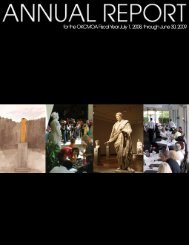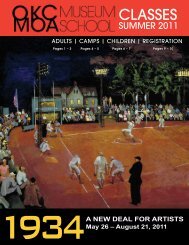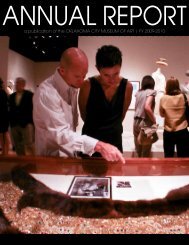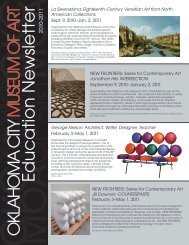Roman Art from the Louvre Educators' Resource Guide
Roman Art from the Louvre Educators' Resource Guide
Roman Art from the Louvre Educators' Resource Guide
You also want an ePaper? Increase the reach of your titles
YUMPU automatically turns print PDFs into web optimized ePapers that Google loves.
20<br />
Discussion Starters<br />
1. Describe <strong>the</strong> scene on this mirror.<br />
What is depicted in <strong>the</strong> central scene?<br />
2. Why do you think <strong>the</strong> artist chose<br />
to depict this Greek myth? What o<strong>the</strong>r<br />
imagery might be appropriate for decorating<br />
a mirror?<br />
3. How has <strong>the</strong> artist adapted <strong>the</strong> scene in<br />
order to fit it onto <strong>the</strong> back of <strong>the</strong> mirror?<br />
4. What visual clues suggest that <strong>the</strong><br />
mirror was made for a woman? What else<br />
might <strong>the</strong> design or <strong>the</strong> material tell us<br />
about who <strong>the</strong> mirror was made for?<br />
5. Do you think silver was an expensive<br />
material in ancient <strong>Roman</strong> times? If so,<br />
why? What o<strong>the</strong>r kinds of silver or o<strong>the</strong>r<br />
luxury objects might <strong>the</strong> owner of this<br />
mirror have had?<br />
Activity: Illustrating Daily Life<br />
Materials: paper, pencils, crayons, markers<br />
Procedure:<br />
1. Ask students to discuss with a partner<br />
or in a small group some of <strong>the</strong>ir daily<br />
activities and <strong>the</strong> objects associated with<br />
<strong>the</strong>se activities.<br />
2. Ask each student to create a list of five<br />
of <strong>the</strong>ir activities and draw <strong>the</strong> associated<br />
objects.<br />
3. Ask students to write a paragraph<br />
describing what <strong>the</strong>y imagine <strong>the</strong> owner of<br />
this mirror to be like, including how and<br />
when <strong>the</strong>y think <strong>the</strong> mirror might have been<br />
acquired, how it might have been used,<br />
and who else may have used it.<br />
4. Ask students to write a paragraph<br />
comparing <strong>the</strong>mselves and <strong>the</strong>ir activities<br />
to <strong>the</strong> imagined activities of <strong>the</strong> owner of<br />
this mirror. Are <strong>the</strong>re any similarities?<br />
1. Mirror<br />
Late 1st century B.C.–1st half of 1st century A.D.<br />
Discovered at Boscoreal (Italy), 1895<br />
Silver, traces of gilding<br />
H. 11K in., Diam. 6H in.<br />
Musée du <strong>Louvre</strong>; Gift 1895, formerly in <strong>the</strong> E. de Rothschild collection<br />
(BJ 2159–inv. mnc 1979)<br />
This delicate two-sided silver mirror was meant to be handheld. One side<br />
is highly polished for reflection, and <strong>the</strong> o<strong>the</strong>r is decorated with an episode<br />
<strong>from</strong> <strong>the</strong> myth of Leda and <strong>the</strong> Swan. The central medallion shows <strong>the</strong><br />
young Leda seated on a rock. Her nude body is barely covered by <strong>the</strong> cloak<br />
(or himation) draped on her legs, and she wears large bracelets on both<br />
arms. Her hair is attractively arranged into a bun with some loose strands<br />
falling around her face. Leda gives water <strong>from</strong> a saucer to a swan, which,<br />
with bent neck and outspread wings, rests its foot on Leda’s knees.<br />
This scene illustrates <strong>the</strong> moment in <strong>the</strong> myth after <strong>the</strong> god Zeus has transformed<br />
himself into a swan in order to seduce Leda, <strong>the</strong> wife of <strong>the</strong> king<br />
of Sparta. The myth of Leda and <strong>the</strong> Swan was very popular in Greece<br />
and spread throughout <strong>the</strong> <strong>Roman</strong> world. It was reproduced in a variety<br />
of different media and was frequently part of <strong>the</strong> painted wall decoration<br />
of elegant homes in Herculaneum and Pompeii—two towns very near to<br />
Boscoreale, <strong>the</strong> site in sou<strong>the</strong>rn Italy outside of Naples where this mirror<br />
was discovered. The inhabitants of Boscoreale were known for <strong>the</strong>ir appreciation<br />
of <strong>the</strong> latest and most refined artistic productions, including precious<br />
silverware and o<strong>the</strong>r luxury objects that reflected <strong>the</strong> wealth, taste,<br />
and social standing of <strong>the</strong> owner.<br />
The sensuous subject of this scene is well suited to <strong>the</strong> use of <strong>the</strong> mirror as<br />
a toiletry object. Mirrors were highly valued by <strong>Roman</strong> women, and it is no<br />
coincidence that <strong>the</strong>ir decoration featured feminine <strong>the</strong>mes.
















